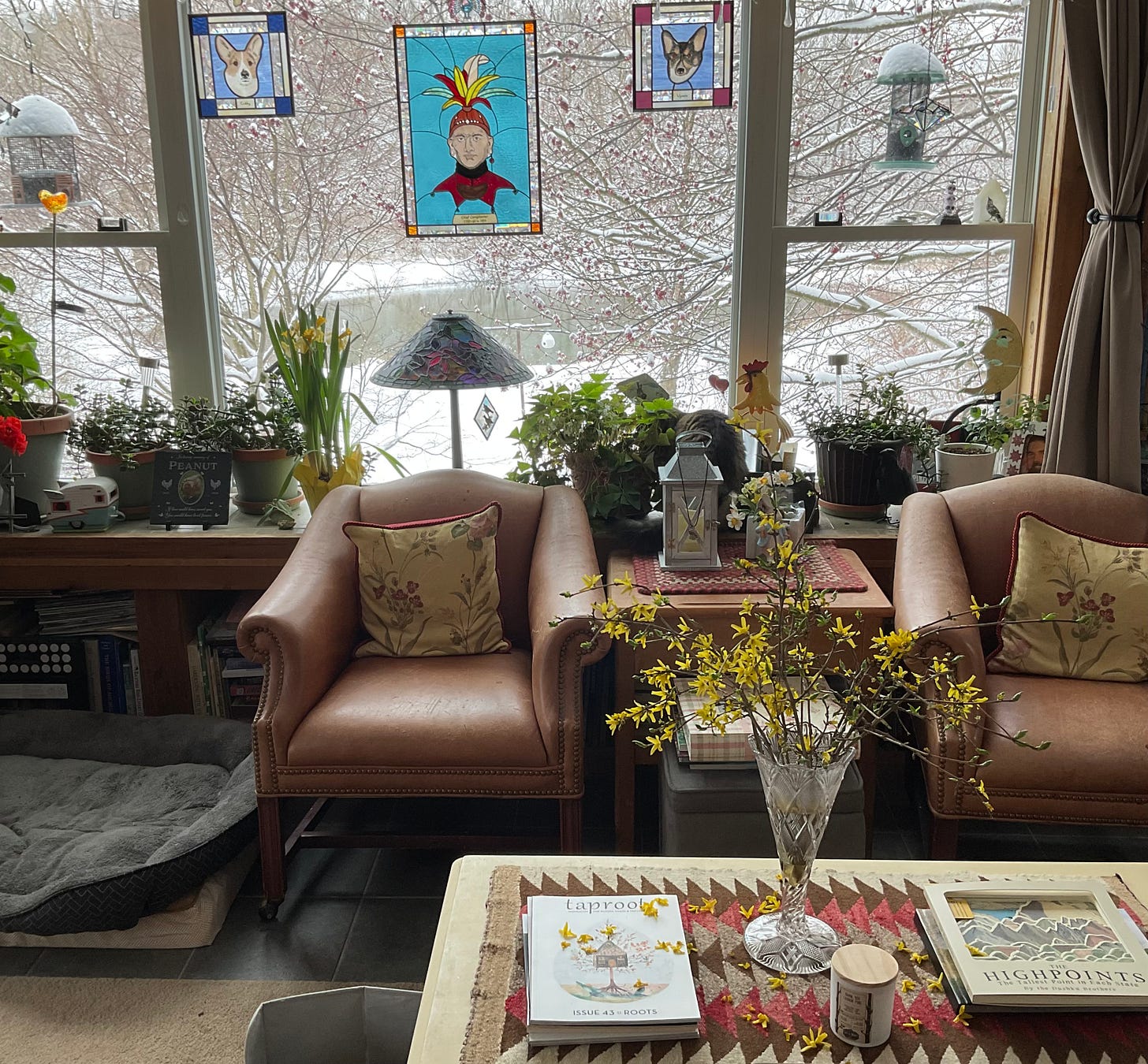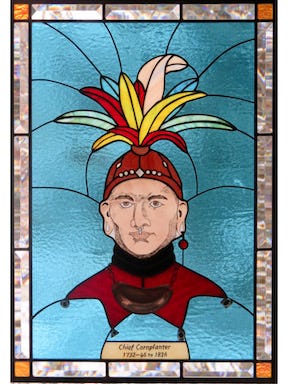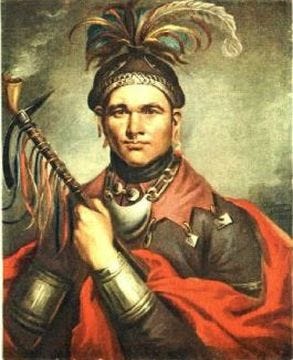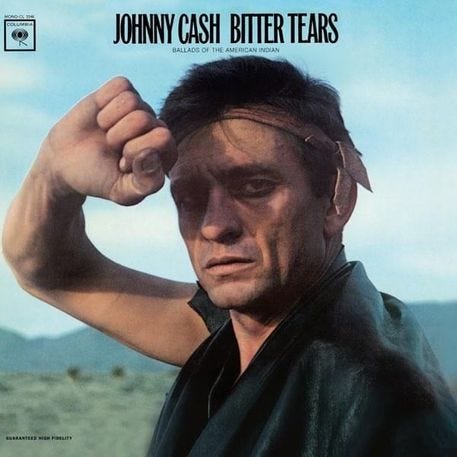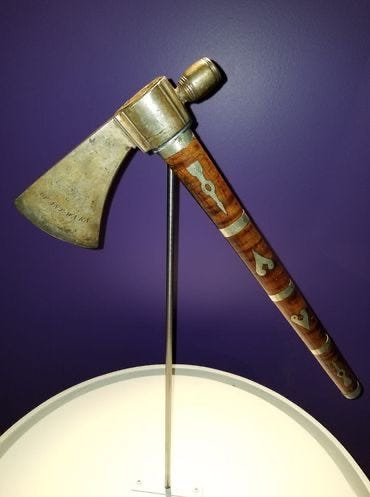It’s spring and Cornplanter is back
A short history of a colorful ancestor
Someone commented about a photo I posted on Facebook recently - “I see Cornplanter is back” - referring to the stained glass window created by my husband as a gift a few years ago. My niece, through extensive genealogical research, had just confirmed my grandparents’ long held belief that Chief Cornplanter was our family’s ancestor. In fact, the property my sister now owns in northwest Pennsylvania was believed to have been the scene of frequent campsites in his travels.
So yes, after a long winter, Cornplanter is back with us. I’m honored by his presence.
Chief Cornplanter (Gaiänt'wakê - he who plants) was born in upstate New York sometime between 1732-46 to a Dutch fur trader and gunsmith named Johannes Abeel and a Seneca princess called Gah-hon-no-neh (She Who Goes to the River.) Cornplanter’s fraternal grandfather was a trader and merchant who was trusted by the indigenous people along his trade routes, and who was the second mayor of Albany, later the capital of New York.
Cornplanter was raised by his mother, a member of the Wolf Clan. He became a war chief, fighting against the settlers at first, but later siding with them in the War of 1812. He became known for his diplomacy in efforts to make peace between his people and the government under Washington.
In gratitude for his diplomatic assistance to the state, in 1796 the federal government gave Cornplanter 1,500 acres in Pennsylvania along the western bank of the Allegheny River about three miles below the southern boundary of New York state, granting it to him and his heirs "forever". It was called the Cornplanter Tract. Later, the government tried to tax the property, but Cornplanter fought and won.
However, when his last direct heir died in 1957, the tract was submerged after construction of Kinzua Dam across the river in 1965 for flood control, forcing the Seneca to move upstate, losing land they had owned for centuries. JFK authorized it in another betrayal by the U.S. Government. Ironically, “as long as the grass shall grow and the river flow” concludes every treaty signed by the government with Native American people, and none were ever honored.
Cornplanter died on his Tract in 1836. Although he requested a grave with no marker, the State of Pennsylvania installed a monument over his grave, believed to be the first monument erected in honor of a Native American in the United States, in 1866.
The honorable James Ross Snowden of Philadelphia gave the dedication:
“He was a dauntless warrior and wisest statesman of his nation, the patriarch of his tribe and the peacemaker of his race. He was a model man from nature’s mould. Truth, temperance, justice and humanity, never had a nobler incarnation or more earnest and consistent advocate then he. As we loved him personally, and revere the noble, manly character he bore, we erect this tribute to his memory, that those who live after us may know and imitate his virtues.”
The relocation of Cornplanter's remains figure in the song, "As Long As The Grass Shall Grow" by Peter LaFarge. Johnny Cash recorded it in 1964 on his “Bitter Tears” album. In one lyric the question is asked, “Cornplanter, can you swim?”
As long as the moon shall rise as long as the rivers flow
As long as the sun will shine as long as the grass shall grow
The Senecas are an Indian tribe of the Iroquios nation
Down on the New York Pennsylvania Line you’ll find their reservation
After the US revolution corn planter was a chief
He told the tribe these men they could trust that was his true belief
He went down to Independence Hall and there was a treaty signed
That promised peace with the USA and Indian rights combined
George Washington gave his signature the Government gave its hand
They said that now and forever more that this was Indian land
As long as the moon shall rise…
On the Seneca reservation there is much sadness now
Washington’s treaty has been broken and there is no hope no how
Across the Allegheny River they’re throwing up a dam
It will flood the Indian country a proud day for Uncle Sam
It has broke the ancient treaty with a politician’s grin
It will drown the Indians graveyards Cornplanter can you swim
The earth is mother to the the Senecas they’re trampling sacred ground
Change the mint green earth to black mud flats as honor hobbles down
As long as the moon shall rise…
The Iroquios Indians used to rule from Canada way south
But no one fears the Indians now and smiles the liar’s mouth
The Senecas hired an expert to figure another site
But the great good army engineers said that he had no right
Although he showed them another plan and showed them another way
They laughed in his face and said no deal Kinzua dam is here to stay
Congress turned the Indians down brushed off the Indians plea
So the Senecas have renamed the dam they call it Lake Perfidy
As long as the moon shall rise…
Washington Adams and Kennedy now hear their pledges ring
The treaties are safe we’ll keep our word but what is that gurgling
It’s the back water from Perfidy Lake it’s rising all the time
Over the homes and over the fields and over the promises fine
No boats will sail on Lake Perfidy in winter it will fill
In summer it will be a swamp and all the fish will kill
But the Government of the USA has corrected George’s vow
The father of our country must be wrong what’s an Indian anyhow
As long as the moon shall rise (look up) as long as the rivers flow (are you thirsty)
As long as the sun will shine (my brother are you warm) as long as the grass shall grow…
A final note:
A pipe tomahawk given to Cornplanter by George Washington in 1792 disappeared from a New York museum in the 1940s, but was returned and put back on display in 2018. (Sadly, I strongly suspect one of my deceased relatives.)



